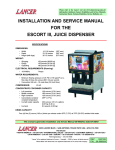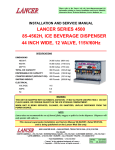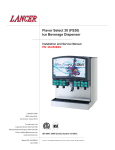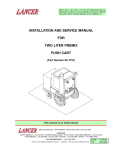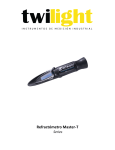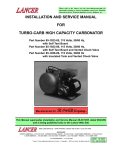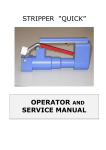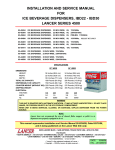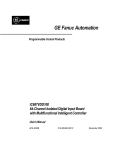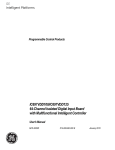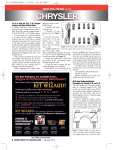Download INSTALLATION AND SERVICE MANUAL FOR LANCER LEV® FILL
Transcript
Please refer to the Lancer web site (www.lancercorp.com) for information relating to Lancer Installation and Service Manuals, Instruction Sheets, Technical Bulletins, Service Bulletins, etc. INSTALLATION AND SERVICE MANUAL FOR LANCER LEV® FILL STATION (LFS), TWO VALVE NOTICE TO USERS: THIS DISPENSER UNIT IS INTENDED FOR IN-DOOR USE ONLY. This manual supersedes Installation and Service Manual, 28-0497, dated 07/02/01. 6655 LANCER BLVD. • SAN ANTONIO, TEXAS 78219 USA • (210) 310-7000 FAX SALES • NORTH AMERICA – 210-310-7245 • INTERNATIONAL SALES – 210-310-7242 • CUSTOMER SERVICE – 210-310-7242 • • LATIN AMERICA – 210-524-9567 / 210-310-7245 • EUROPE – 32-2-755-2399 • PACIFIC – 61-8-8268-1978 • FAX ENGINEERING: • 210-310-7096 "Lancer" is the registered trademark of Lancer • Copyright — 2001 by Lancer, all rights reserved. LEV® is a registered trademark of the Coca-Cola Company. REV: P.N. 08/15/01 28–0497/01 TABLE OF CONTENTS NOTICE TO USERS................................................................................................................................COVER TABLE OF CONTENTS ......................................................................................................................................i WARRANTY STATEMENT .................................................................................................................................i INTRODUCTION TO THE LANCER LEV® FILL STATION (LFS), TWO VALVE .............................................ii 1. SPECIFICATIONS .......................................................................................................................................1 2. INSTALLATION ...........................................................................................................................................1 2.1 RECEIVING........................................................................................................................................1 2.2 UNPACKING ......................................................................................................................................1 2.3 INSTALLATION ..................................................................................................................................1 2.4 CONNECTING TO ELECTRICAL POWER .......................................................................................2 2.5 CONNECTING SUPPLY LINES TO SOURCES ................................................................................2 3. SCHEDULED MAINTENANCE ...................................................................................................................2 3.1 DAILY .................................................................................................................................................2 3.2 BIWEEKLY SANITIZING ....................................................................................................................2 3.3 EVERY SIX MONTHS........................................................................................................................2 4. DISPENSER CLEANING AND SANITIZING ..............................................................................................2 4.1 AMBIENT PROCESS .........................................................................................................................2 5. OPERATION OF THE LFS..........................................................................................................................3 5.1 CONNECTIONS .................................................................................................................................3 5.2 INITIAL POWER UP...........................................................................................................................4 5.3 AUTO MODE......................................................................................................................................4 5.4 MANUAL MODE.................................................................................................................................4 5.5 SETTING THE DESIRED RATIO.......................................................................................................4 5.6 CHANGING SYRUP PACKAGE PROCEDURE ................................................................................5 5.7 CHANGING THE BOX OF SYRUP....................................................................................................5 5.8 FUNCTIONS AND ALARMS ..............................................................................................................5 6. TROUBLESHOOTING.................................................................................................................................5 6.1 GREEN POWER LIGHT DOES NOT COME ON ..............................................................................5 6.2 UNDER SOLD OUT CONDITION, SOLD OUT ALARM SOUNDS, BUT THE RED SOLD OUT LED DOES NOT FLASH........................................................................................6 6.3 UNIT WILL NOT GO INTO AUTO MODE ..........................................................................................6 6.4 SOLD OUT ALARM DOES NOT SHUT OFF.....................................................................................6 6.5 WATER NOT DISPENSING FROM VALVE .......................................................................................6 6.6 RED LIGHT ON CIRCUIT COMES ON OR GREEN LIGHT ON THE CIRCUIT BOARD DOES NOT COME ON ..........................................................................6 6.7 WATER LEAKAGE AROUND NOZZLE .............................................................................................6 6.8 LEAKAGE BETWEEN UPPER AND LOWER BODIES.....................................................................6 6.9 MISCELLANEOUS LEAKAGE ...........................................................................................................6 6.10 INSUFFICIENT WATER FLOW..........................................................................................................6 6.11 INSUFFICIENT SYRUP FLOW..........................................................................................................6 6.12 ERRATIC RATIO oBRIX .....................................................................................................................7 6.13 NO PRODUCT DISPENSED .............................................................................................................7 6.14 WATER ONLY DISPENSED, NO SYRUP, OR SYRUP ONLY DISPENSED, NO WATER ...............7 6.15 VALVE WILL NOT SHUT OFF ...........................................................................................................7 6.16 EXCESSIVE FOAMING .....................................................................................................................7 7. ILLUSTRATIONS, PARTS LISTINGS, AND WIRING DIAGRAMS ............................................................8 7.1 CONTROL BOX ASSEMBLY, FRONT VIEW .....................................................................................8 7.2 PLUMBING.........................................................................................................................................9 7.3 WIRING HARNESS DIAGRAM........................................................................................................10 7.4 CONTROL BOX ASSEMBLY, REAR VIEW......................................................................................11 7.5 INTERNAL COMPONENTS .............................................................................................................12 7.6 WIRING DIAGRAM ..........................................................................................................................13 WARRANTY STATEMENT Lancer warrants that equipment and parts are free from defects in material and workmanship under normal use and service. If there are questions, contact the Lancer Warranty Department (1-800-729-1565), providing the Equipment type/series/model, serial number and the date of purchase. The Lancer Certificate of Warranty (PN 38-0508/03) is available upon request. i Introduction to the Lancer LEV® Fill Station (LFS), Two Valve Power Switch Power Switch LEV R Probe Assembly, LO Level Probe Assembly, HI Level Probe Assembly, LO Level LEV R Probe Assembly, LO Level LED (Red), Sold Out Probe Assembly, LO Level LED (Green), Power Front View, LFS 3/8" Water Inlet 3/8" Syrup Inlet 3/8" Water Inlet 3/8" Syrup Inlet Power Cord, Three Prong, Grounded Rear View, LFS ii Probe Assembly, HI Level 1. SPECIFICATIONS SHIPPING WEIGHT Fourteen (14) pounds (6.4 kg) DIMENSIONS 25.5" x 5.5" x 6.5" (64.77 cm x 13.97 cm x 16.51 cm) ELECTRICAL 115V/60Hz/2.0A ELECTRICAL 115V/60Hz/1.0A (Power Cord is provided with three prong grounded plug) INLET SYRUP CONNECTIONS 3/8 inch Male Flare INLET WATER CONNECTIONS 3/8 inch Male Flare FLOW 2. INSTALLATION 2.1 4.5 ounces per second RECEIVING Each unit is completely tested under operating conditions and thoroughly inspected before shipment. At the time of shipment, the carrier accepts the unit and any claim for damage must be made with the carrier. Upon receiving unit(s) from the delivering carrier, carefully inspect carton for visible indication of damage. If damage exists, have carrier note same on bill of lading and file a claim with the carrier. 2.2 UNPACKING A. Carefully remove unit from shipping carton. B. Inspect unit for concealed damage. If damage exists, notify delivering carrier note and file a claim against the carrier. 2.3 INSTALLATION WARNING DISCONNECT SLUSH MACHINE FROM POWER SOURCE BEFORE BEGINNING INSTALLATION OF THE LANCER LEV® FILL STATION TO AVOID POSSIBLE FATAL ELECTRICAL SHOCK OR SERIOUS INJURY. Figure 1 Mounting A. The dispenser is designed for in-door use ONLY and to be mounted on unit, in a well lighted, visible area. CAUTION FAILURE TO MAINTAIN PROPER AIR CLEARANCE WILL CAUSE THE UNIT TO OVERHEAT AND WILL RESULT IN PREMATURE COMPONENT FAILURE. B. Locate slush machine with approximately five (5) inches clearance between a wall and the back of the LFS unit. Follow slush machine manufacturer’s installation instructions for side and rear ventilation requirements. C. If required, locate and mark five (5) holes using base of fill station (see Figure 1). D. Cover hopper with lid before drilling holes. CAUTION ENSURE HOLES ARE CAREFULLY DRILLED TO AVOID DRILLING TOO DEEP AND THEREBY POSSIBLY DAMAGING REFRIGERATION LINES. E. Drill five (5) holes using a #19 drill bit (0.166) drill bit. F. Using the ROLOC screws provided (PN 04-0558), attach the LFS to the slush machine. 1 2.4 CONNECTING TO ELECTRICAL POWER WARNING THIS UNIT MUST BE PROPERLY ELECTRICALLY GROUNDED TO AVOID POSSIBLE FATAL ELECTRICAL SHOCK OR SERIOUS INJURY TO THE OPERATOR. THE POWER CORD IS PROVIDED WITH A THREE PRONG GROUNDED PLUG. IF A THREE-HOLE GROUNDED ELECTRICAL OUTLET IS NOT AVAILABLE, USE AN APPROVED METHOD TO GROUND THE UNIT. DO NOT USE EXTENSION CORDS WITH THIS UNIT. DO NOT "GANG" TOGETHER WITH OTHER ELECTRICAL DEVICES ON THE SAME OUTLET. A. Check the dispenser serial number plate for unit's correct electrical requirements. Do not plug into electrical outlet unless unit electrical configuration, located on serial plate, agrees with local available power supply. B. Route the power supply cord to a grounded electrical outlet of the proper voltage and amperage rating, and plug in the unit. 2.5 CONNECTING SUPPLY LINES TO SOURCES A. Connect free end of plain water lines to water supply [must be 30-110 PSI (2.1 to 7.6 BAR)]. B. Mark both ends of product and water lines and route to dispenser. Flush lines to be sure each is clean. Failure to do so may result in clogging of valve(s), resulting in improper operation. Connect lines to dispenser and secure using Oetiker clamps. C. Turn on water supply. D. Open all dispenser valves until air is bled from system. E. Actuate valve until a smooth flow of water is obtained by holding in Manual Mode. F. Check for leaks. G. Connect free ends of product lines to bag-in-box. H. Activate syrup pump until smooth flow of syrup is obtained by holding in Manual Mode. I. Check for syrup leaks. J. Adust the water flow. K. Adjust water to syrup (ratio) brix (see Section 5.5). 3. SCHEDULED MAINTENANCE Drain host product unit hopper before starting the sanitization process to prevent overfilling. The LFS must be sanitized first. 3.1 DAILY CLEANING A. Nozzle and diffuser must be cleaned daily. 1. Remove nozzle by twisting counter clockwise and pulling down. 2. Remove diffuser by pulling down. 3. Wash nozzle and diffuser with warm water. DO NOT use soap or detergent. This will cause foaming and off taste in finished product. 4. Reinstall diffuser and nozzle. 5. With a clean cloth and warm water, wipe off all of the unit's exterior surfaces. DO NOT USE ABRASIVE SOAPS OR STRONG DETERGENTS. 6. Taste each product for off tastes and/or brix changes. 7. Check for leaks. 3.2 BI-WEEKLY SANITIZING Nozzle and diffuser must be sanitized bi-weekly. Comply with the instructions of the dispenser manufacturer to properly sanitize the nozzle and diffuser, and ensure no off-taste is present. 3.3 EVERY SIX MONTHS Clean and sanitize the LFS unit using the appropriate procedures outlined in Section 4 of this manual. 4. DISPENSER CLEANING AND SANITIZING 4.1 AMBIENT PROCESS A. The ambient process is the most common method for cleaning and sanitizing dispenser equipment. The detergent should be caustic-based and the sanitizer should be a low pH (less 2 than 7.0) chloride solution. B. Disconnect syrup containers and remove product from tubing by purging with water. C. Rinse the lines and fittings with clean, room temperature water to remove all traces of residual product. D. Fill lines with a caustic-based (low-sudsing, non-perfumed, and easily rinsed) detergent solution. The solution should be prepared in accordance with the manufacturer's recommendations, but should be at least two (2) percent sodium hydroxide. Make sure the lines are completely filled and allow to stand for at least ten (10) minutes. E. Flush the detergent solution from the lines with clean water. Continue rinsing until testing with phenolpthalein shows that the rinse water is free of residual detergent. F. Fill the lines with a low pH (7.0) chlorine solution containing at least 100 parts per million (PPM) (100 mg/L) available chlorine. Make sure that lines are completely filled and allow to stand for ten (10) minutes. G Nozzle/Diffuser Sanitizing Use the following procedure to sanitize the nozzle housing during dispenser sanitization. 1. Cleaning Solution - Prepare a low sudsing, non-perfumed, and easily rinsed detergent solution and clean, potable water at a temperature of 90° to 110°F. 2. Sanitizing Solution - Prepare a chlorine solution (less than pH 7.0) containing 100 PPM available chlorine with clean, potable water at a temperature of 90° to 110°F. Any sanitizing solution may be used as long as it is prepared in accordance with the manufacturer's written recommendations and safety guidelines, and provides 100 PPM available chlorine. 3. Cleaning Procedure CAUTION BE CAREFUL NOT TO GET SANITIZING SOLUTION ON THE CIRCUIT BOARD. a. b. c. d. e. Disconnect power, so the valve will not be inadvertently activated while cleaning. Remove nozzle housing by twisting it counter-clockwise and pulling it down. Wash the nozzle housing with the cleaning solution. Immerse the nozzle housing in a bath of the sanitizing solution for 15 minutes. While the parts are in the sanitizing solution, visually inspect around the nozzle mounting area for syrup residue. Using a cloth or nozzle brush and sanitizing solution, clean this area and the bottom of the nozzle body. f. Wipe off the valve shroud assembly and any other areas that may have been splashed by syrup. g. Wearing sanitary gloves, remove, drain, and air dry the nozzle housing. h. Make certain the nozzle o-ring is in place around the nozzle mounting area on the valve. If necessary, slide a new nozzle o-ring (PN 02-0228) onto the nozzle mounting area. (Wear sanitary gloves while handling the o-ring.) If needed, apply 111 lubricant (or another FDA approved lubricant) to the o-ring. i. Wearing sanitary gloves, install the nozzle housing by inserting it into the nozzle body and twisting it clockwise to lock it in place. j. Connect power and replace cover. k. Reconnect syrup containers and ready Unit for operation. WARNING REMOVE SANITIZING SOLUTION FROM DISPENSER AS INSTRUCTED. RESIDUAL SANITIZING SOLUTION LEFT IN SYSTEM COULD CREATE HEALTH HAZARD. l. Draw drinks to refill lines and flush the chlorine solution from the dispenser. NOTE Please note that a fresh water rinse cannot follow sanitization of equipment. Purge only with the end use product. This is an NSF requirement. m. Taste the beverage to verify that there is no off taste. 5. OPERATION OF THE LFS 5.1 CONNECTIONS A. Attach 3/8” syrup hoses between syrup (BIB), syrup pump, and the unit. Inlet syrup hose, 3/8”, attaches to left side of unit. 3 B. Attach CO2 connection to syrup pump. NOTE: The unit recognizes the left side of the unit as syrup and right side as water. WARNING: FAILURE TO RUN UNIT WITHOUT WATER LINES CONNECTED WILL RESULT IN OVERHEAT OF THE SOLENOID VALVES. C. Attach water lines from water source or prechiller to the unit. 5.2 INITIAL POWER UP A. Insure the switches on the unit are set to the middle (OFF) position. B. Plug in the unit. 5.3 AUTO MODE A. Switch the unit into AUTO Mode. The Green power light will come on and the valve will start dispensing syrup and water out of the valve. 5.4 MANUAL MODE A. Switch the unit in MANUAL Mode (this requires holding down the switch). The Green power light will come on and the valve will start dispensing syrup and water out of the valve. 5.5 SETTING THE DESIRED RATIO The ratio of BIB slush for Sonic should only be set at 4.5:1. This is the approved ratio for this product. Use the special 4.5:1 and 5.0:1 Ratio Cup to target (Coca-Cola PN 15507). Follow the same valve ratio targeting method that is used to set the LEV® for fountain dispensing. IMPORTANT NOTE TO TECHNICIAN: Failure to properly set the LFS LEV® for 4.5:1 ratio can result in damage to the customer-owned slush dispenser. Low brix (high ratio) can lead to barrel freeze up and subsequent motor/part damage. High brix (low ratio) can lead to longer than normal freeze down times. A. ADJUSTING WATER FLOW The Model 145 LEV® water flow may be adjusted from 2.0 oz/sec (59.2 ml/sec) to 4.50 oz/sec (133.2 ml/sec). The restricted flow adjustment plug adjusts to a maximum flow of 3.3 oz/sec (97.7 ml/sec). 1. 2. 3. 4. Slide I.D. panel UP until flow control adjustments are exposed (see Figure 2). Remove nozzle by twisting counter clockwise and pulling down. Remove diffuser by pulling down. Install Lancer syrup separator (PN 54-0201, smoke, for Model 145 valves) in place of the nozzle. 5. Activate valve to fill separator syrup tube. I.D. PANEL (Shown in 6. Hold a Brix cup under syrup separator. Dispense open position) water and syrup into cup for two (2) seconds. Divide number of ounces (ml) of water in cup by two (2) to determine water flow rate per second. COVER SCREW FLOW CONTROL 7. To obtain desired water flow rate, use a screwdriver FLOW CONTROL WATER SYRUP to adjust water flow control (see Figure 2). B. ADJUSTING WATER TO SYRUP BRIX The Model 145 syrup flow may be adjusted from 0.50 oz/sec (14.8 ml/sec) to 0.90 oz/sec (26.6 ml/sec). 1. Hold the Brix cup under the syrup separator and activate valve. Check Brix. 2. To obtain desired Brix, use screwdriver to adjust syrup flow control (see Figure 2). 3. Remove syrup separator. 4 Increase Decrease Increase Decrease NOZZLE (WITH DIFFUSER INSIDE) Valve Adjustment FIgure 2 4. Install diffuser and nozzle. 5. Slide I.D. panel (Valve Cover) down. WATER STEMS STEMS OPEN Mounting Block Stems in OPEN Position CLOSED Mounting Block Stems in CLOSED Position FIgure 4 FIgure 3 5.6 SYRUP WATER SYRUP CHANGING SYRUP PACKAGE PROCEDURE When a package of syrup is empty and the unit is in AUTO mode or MANUAL mode, the SOLD OUT light will blink and the alarm will sound until a new package is replaced as described in Section 5.7. 5.7 CHANGING THE BOX OF SYRUP A. If the ratio does not need to be changed: 1. Put the switch in the AUTO position. 2. The unit should be ready to fill in the AUTO mode again. B. If the ratio does need to be changed: 1. Put the Switch in OFF mode and use MANUAL mode to dispense product as needed. 2. Follow the procedure to change the ratio (see Section 5.5). 3. Put the Switch in AUTO mode to go into AUTO fill mode. The unit should be ready to fill in the AUTO mode again. 5.8 FUNCTIONS AND ALARMS A. Probes monitor the level of product in the hopper if the level of product flows below the Lo probes then the valve comes on and begins filling the hopper until contact is made with both Lo probes plus an additional 17 seconds after that and then shuts off. If the level of product ever comes in contact the Hi probe then the valve shuts off until the level drops below this probe. (Applies for AUTO and MANUAL Mode.) B. Sold out Alarm monitors the amount of syrup in the bag in the box when the level is low the pressure switch activates and triggers an alarm and red led light which will blink. The alarm can be turned off by replacing the bag in the box, changing the CO2 bottle or switching the unit in MANUAL. NOTE: By switching the unit in MANUAL and then back into AUTO, you turn the sound alarm only OFF. The red SOLD OUT switch continues to blink until one of the above is performed. 6. TROUBLESHOOTING TROUBLE 6.1 Green power light does not come on. CAUSE REMEDY A. Unit not plugged in. B. Loose connection. C. Polarity incorrect (wires crossed). D. Failed transformer. E. Failed PCB. 5 A. Check to ensure unit is plugged in. B. Unscrew cover and ensure all connections are secure. C. Looking at terminals (LED away from you), ensure flat side of the rectangle (between the terminals) is at bottom and that the red positive wire is on the right terminal. D. Replace transformer. E. Replace PCB. TROUBLE CAUSE REMEDY 6.2 Under SOLD OUT condition, SOLD OUT alarm sounds, but the Red SOLD OUT LED does not flash. A. Loose connection. B. Polarity incorrect (cables crossed). A. Ensure cables are secure. B. Looking at terminals (LED away from you), ensure flat side of the rectangle (between the terminals) is at bottom and that the red positive wire is on the right terminal. 6.3 Unit will not go into AUTO mode. A. Loose connection. A. Check to ensure cables plugged in correctly. B. Replace Switch. C. Replace PCB. SOLD OUT Alarm does not shut OFF. A. Pressure Switch is ON. 6.4 B. Switch is broken. C. Failed PCB. B. Failed PCB. A. 1. Check Syrup supply. 2. Check Syrup Bag Line Connections. 3. Check CO2 supply. 4. Check for loose connection. 5. Replace pressure switch. B. Replace PCB. 6.5 Water not dispensing from valve. 6.6 Red light on the circuit A. Loose connection. A. Check all connections. comes on or Green B. Bad solder joint or failed PCB. B. Replace PCB. light on the circuit board does not come on. 6.7 Water leakage around nozzle. A. O-ring is not properly installed A. Install or replace o-ring correctly. above diffuser. B. O-ring is damaged or missing. B. Replace o-ring. 6.8 Leakage between upper and lower bodies. A. One or more retaining screws loose. B. Paddle arm assemblies are worn or damaged. A. Tighten all six (6) retaining screws. Miscellaneous leakage. A. Gap between parts. A. Tighten appropriate retaining screws. B. Replace appropriate o-rings. 6.9 A. Water is not on. A. Check water supply. B. Chiller is clogged or shut OFF. B Ensure there are no leaks or clogs in the chiller and that chiller is ON. B. Damaged, missing, or improperly installed o-rings. 6.10 Insufficient water flow. A. Water flowing pressure is too low, or restricted. B. Foreign debris in water flow controls. 6.11 Insufficient syrup flow. A. Syrup flowing pressure is too low, or restricted. B. Foreign debris in syrup flow controls. 6 B. Replace paddle arm assemblies. A. 1. Check incoming water from carbonator to ensure minimum flowing pressure. See SPECIFICATIONS. 2. Check stems on mounting block to ensure it is in fully OPEN position. B. Remove water flow control from upper body and clean out any foreign materials to ensure smooth free piston movement. A. 1. Check incoming syrup to ensure minimum flowing pressure. See SPECIFICATIONS. 2. Check shutoff on mounting block to ensure it is in fully OPEN position. B. Remove syrup flow control from upper body and clean out any foreign materials to ensure smooth free piston movement. TROUBLE CAUSE REMEDY 6.12 Erratic Ratio oBrix. A. Incoming water and/or syrup supply not at sufficient flowing pressure. B. Foreign debris in water and/or syrup flow controls. A. Check incoming water and syrup supply to ensure sufficient flowing pressure. B. Remove flow controls and clean out any foreign materials to ensure smooth free piston movement. 6.13 No product dispensed. A. Water and syrup shutoffs are not fully OPEN. A. Check stems on mounting block to ensure they are in fully OPEN position. B. If not, repair or replace. B. Ensure cup lever arm, or I.D. Panel actuator is actuating switch. C. Electric current not reaching valve. D. Improper or inadequate water or syrup supply. E. BIB empty. C. Check electric current supplied to valve. See SPECIFICATIONS. If current is adequate, check solenoid coil and switch. Replace if necessary. D. Remove valve from mounting block and open stems slightly and check to ensure proper water and syrup supply. If no supply, check dispenser for freeze-up or other problems. E. Replace BIB. 6.14 Water only dispensed, no syrup; or syrup only dispensed, no water. A. Water or syrup stem on mounting block not fully OPEN. B. Improper or inadequate water or syrup supply. A. Check stems on mounting block to ensure they are in full OPEN position. B. Remove valve from mounting block and open stem slightly to check for proper syrup and water supply. If no supply, check dispenser for freeze-up or other problems. 6.15 Valve will not shut OFF. A. Cup Lever may be sticking or binding. B. Switch not actuating properly. C. Solenoid armature not returning to bottom position. D. Debris or damage to Paddle arms. A. Correct or replace lever. 6.16 Excessive foaming. A. Incoming water or syrup temperature too high. B. Water flow rate too high. C. Nozzle and diffuser not clean. D. Nozzle and diffuser not properly installed. E. CO2 pressure too high. NOTES 7 B. Check switch for free actuation. C. Replace defective solenoid armature or spring. D. Remove debris and/or replace damaged paddle arms. A. Correct at dispenser. B. Readjust and reset oBrix. See Section 5.5. C. Remove and clean. D. Remove and install properly. E. Check for proper pressure setting. 7. ILLUSTRATIONS, PARTS LISTINGS, AND WIRING DIAGRAMS 7.1 CONTROL BOX ASSEMBLY, FRONT VIEW 3 2 4 1 13 14 15 16 12 11 10 9 8 7 6 5 16 Item Part No. 1 2 3 R4 5 6 7 8 Description Item Part No. 9 10 11 12 Description LED, Green, Snap Mount, 5VDC LED, Red, Snap Mount, 5VDC Bushing, Strain Relief, 0.312 OD LEV®, 4.5, W/O C, L, S, WH (includes back block) 13 04-1089 Screw, 10 - 32, RH, PFH/SL, 1.000 14 54-0029/01 Cover, Subassy, LEV®, Lift-Off 15 05-0287/02 Panel, ID. LEV®, Basic, Lift-Off 16 51-1414 Lid, Hopper, SS Control Box Assy, 2 LEV®, LFS Cover, 2 LEV®, LFS Screw, 10 - 32 x 0.250, THD, SL, MS, SS 06-2520/01 Decal, Wiring Diagram, 2 LEV®, LFS 06-2483 Label, Switch, LFS 12-0446 Switch, Rocker, Double Pole, Double Throw 06-2484 Label, Power LED, LFS 06-2485 Label, Sold-Out LED, LFS 51-1411 30-3170 04-0148 12-0448 12-0447 13-0005 19-0181/01 R in margin indicates new or revised material 8 7.2 PLUMBING 1 7 3 4 2 6 5 Item Part No. 1 2 12-0115 01-2207 3 4 5 6 08-0461 01-0012 02-0005 07-0433 7 01-2241 Description Switch, Pressure, Assy, Syrup Out Tee, SS, 1/4 Barb X 1/4 Barb X 1/4 NPT Tubing, Redline, 0.265 x 0.457 Adaptor, 1/4 Barb x Dole O-Ring, 2-010 Clamp, Hose, STPLS, 13.3 mm (1/2”) Fitting, Bulkhead, SS, 3/8 FLR x 1/4 Barb 9 7.3 WIRING HARNESS DIAGRAM 2 3 4 TO SWITCH 5 TO LED TO PRESSURE SWITCH 6 TO GROUND STUD TO VALVE 1 8 TO SECONDARY TO PROBES 7 TO PRIMARY Item Part No. 1 2 3 4 5 6 7 8 52-2511 52-2538 52-2498 11-0180 52-2497 52-2500 52-2509 52-2539 Description Harness, Valve to PCB, LFS Harness, Switch, 2 LEV®, LFS Harness, LED, LFS Connector, Housing, Wire to Board Harness, Sold Out Valve, LFS Harness, Probe, LFS Cord Assy, Power, 115V, LFS Harness, Transformer to PCB, 2 LEV®, LFS 10 7.4 CONTROL BOX ASSEMBLY, REAR VIEW 11 10 9 WATER SYRUP WATER 8 SYRUP 2 7 6 5 3 4 1 Item Part No. 1 2 30-3169 04-0558 3 4 30-3134 04-0148 5 6 7 8 07-0575 13-0028 30-3135 04-0045 9 04-0684 10 06-0112 11 06-0075-01 Description Base, 2 LEV®, LFS Screw, 10 - 32 x 0.375, ROLOC, Phillips Hinge, Bottom, LFS Screw, 10 - 32 x 0.250, THD, SL, MS, SS Hinge, SS, Concealed, Removable Relief, Strain, 7/8” DIA Support, Syrup and Water, LFS Cap, Protective, Shipping, 5/8 - 18 Nut, Hex, 5/8 - 18, JAM, SST Label, Water Nameplate, Vinyl, PN/SN/ELEC Only 11 7.5 INTERNAL COMPONENTS 1 2 3 14 4 5 13 10 12 11 9 8 7 7 6 Item Part No. 1 25-0039 2 04-0504 3 04-0286 4 5 52-2502 05-1535 6 7 52-2493 52-2492 Description Item Part No. 8 9 10 11 12 Transformer, 120V/50-60Hz, 24V, 50VA Screw, 8 - 18 x 0.375, PHD, W/ELW, PH, AB Nut, Hex, 10 - 24 x 5/16, SS, KEPS Washer PCB Assy, LFS Support, PCB, 0.156 x 0.187 x 0.25 OH Probe Assy,, HI Level, LFS Probe Assy, LO Level, LFS 04-1315 04-1285 30-3131 04-1053 04-1308 13 03-0095 14 03-0342 12 Description Washer, Flat, 3/8 x 5/8 x 1/16 Thick Nut, SS, 3/8 - 16 Kick Stand, LFS Screw, Shoulder, 10 - 24, Draft Washer, Flat, 0.032 x 0.265 ID x 0.500 OD, SS Spring, Outside, Yoke Ring, Retaining, 1/8 Shaft, External, Self Locking 13 + GRN LED + P1 LO ® PC BOARD J6 52-2497 06-2520/01 WIRING DIAGRAM, 2 LEV, LFS J3 J2 BLK RED LED WHT HI J1 LO BLK RED WHT LED AWAY FLAT DOWN CONNECT RED TO RIGHT TAB RED 52-2498 J7 J5 J4 11-0180 52-2538 PROBES COM NO WHT BLK 52-2539 PRI 52-2509 TRANSFORMER SEC 52-2511 WHT BLK TO VALVE BLU RED SWITCH GRY PUR BLK WHT ON GRN LED + RED LED + BLK J2 52-2498 BLK RED 52-2498 BLK 52-2500 RED J3 52-2498 BLK RED LED AWAY FLAT DOWN CONNECT RED TO RIGHT TAB 52-2497 P1 PC BOARD J6 LO WHT NC GRN/YEL HI J1 LO BLK RED BLK 52-2500 PRESSURE SWITCH WHT J7 J5 J4 11-0180 52-2538 PROBES COM NO NC 52-2511 TO VALVE BLU RED PUR GRY SWITCH ON BLK WHT PRESSURE SWITCH 7.6 WIRING DIAGRAM





















